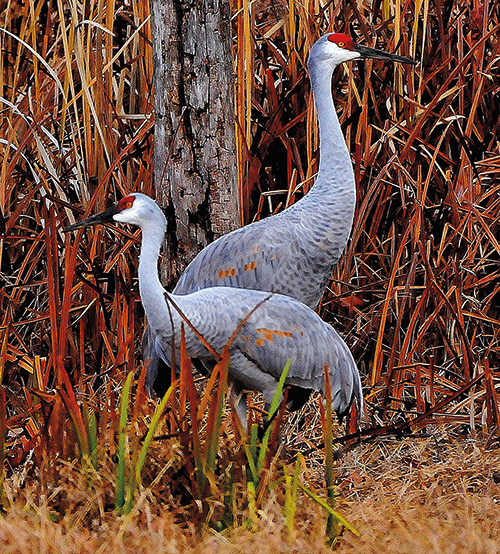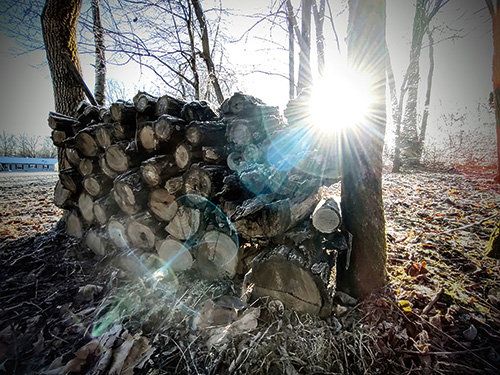About Outdoor Indiana
Outdoor Indiana, the state's premier magazine, delivers the wonders of the Hoosier outdoors to subscribers' homes and offices six times a year in 48 pages of vibrant color. For the best of state parks, lakes, wildlife, forests, trails, hunting, fishing, wildflowers and outdoorsy people, plus inside information from DNR experts, subscribe for $15 per year or $28 for two years. Follow the magazine staff on Facebook.
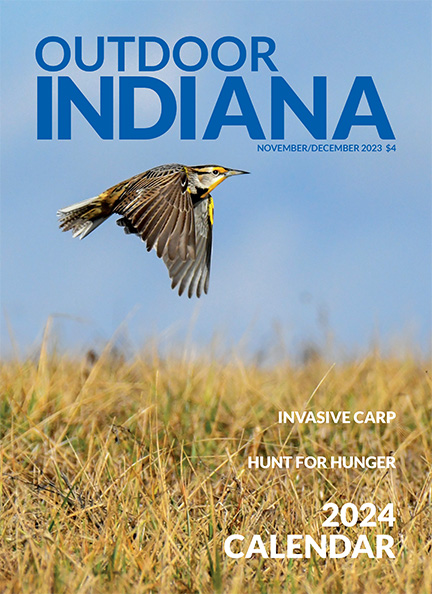
An Eastern meadowlark takes flight over a Daviess County farm field.
Featured Stories
- From the Director
LIGHTING THE WAY

DNR Director Dan Bortner
During the dark days of the Great Depression, a group of young men at Ouabache State Park in northeast Indiana had a bright idea.
They were members of the Civilian Conservation Corps (CCC), a national service program that put unemployed young men to work on conservation projects. As you travel across Indiana today, you’ll see the fruits of their labor, from picnic shelters to the popular toboggan run at Pokagon State Park near Angola.
In 1939, these young men at Ouabache assembled 16 strands of blue lights and strung them from their flagpole to form a Christmas tree that gleamed bright through the cold winter. The display attracted visitors from miles around, providing hope in a time when there was little.
One of those CCC young men was my wife’s grandfather, George Guthrie. George helped dig Kunkel Lake, one of Ouabache’s main attractions and a point of family pride!
The ingenuity of those men continues to provide a guiding light at the park today. More than 80 years later, the Friends of Ouabache State Park organizes the annual Wonderland of Lights. It’s a drive-through exhibit where guests enjoy more than 40 holiday light displays in the campground as well as a light show synchronized to music at the park’s CCC-built fire tower.
Last year, more than 2,700 vehicles traversed this wonderland, which runs nightly in December from 6 to 9 p.m.
Witness the shimmering lights at Ouabache this holiday season and feel the warm nostalgia of a CCC-sparked Hoosier tradition.
- FIRST LADY TOUTS HUNT FOR HUNGER PROGRAM
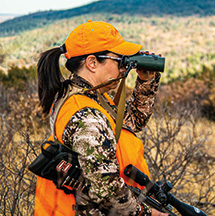
Indiana First Lady Janet Holcolm
HOW HUNTERS CAN HELP FEED HUNGRY HOOSIERS
Guest Article By Indiana First Lady Janet HolcolmMy first experience afield occurred on a crisp fall day I still remember vividly nearly a decade later. The sky was clear and the sun shone brightly, illuminating the colorful splendor of a southern Indiana wood line that punctuated the rolling terrain. The field around me was a pallet of green and gold, and a pair of German shorthaired pointers bounded through the tall grasses in search of pheasant and quail.
That day I took home my first game meat and embarked on a new pursuit. I began learning more about the many ways hunting impacts our state, from controlling wildlife populations to funding habitat restoration and more.
I certainly hadn’t anticipated the camaraderie and social aspects of this pursuit. The time spent exchanging stories, ideas, and suggestions helps bolster dreams of future hunts, and the possibilities of new game, new terrain, and new experiences. You know you’re a particularly special friend if a hunter shares their game meat with you. This spirit of sharing extends beyond hunting circles to other communities so they too can benefit from the harvest, particularly Hoosiers who may not have enough to eat.
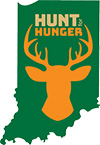
Indiana Hunt for Hunger connects hunters, processors, and food banks to provide protein to those in need. In recent years, Hoosier hunters have donated thousands of deer that add up to hundreds of thousands of meals for hungry Hoosiers. Formerly known as the Sportsmen’s Benevolence Fund, this rebranded program intends to do even more this hunting season, and you can help!
The Indiana Department of Natural Resources, partnering with the Dubois County Sportsmen's Club, Hoosiers Feeding the Hungry, and Hunters and Farmers Feeding the Hungry, aims to connect with more Hoosier hunters to help supply much-needed protein for food banks across our state. Protein is one of the most expensive and difficult-to-find items for food programs, but with the help of hunters, we can fill the freezers for months to come.
I wish all Hoosier hunters a safe and successful hunting season. While you enjoy your time outdoors, please consider donating all or part of your harvest to our neighbors in need.
- INVASION COULD BECOME DINNER
Progress, status, and solutions regarding invasive carp
By Marty Benson, OI staff
Photography by John Maxwell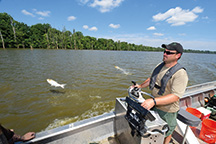
Silver carp startled by boat-motor vibrations leap from Hovey Lake near a research boat piloted by DNR fisheries biologist Craig Jansen.
Their journey to Indiana started in the 1960s and '70s, from the lower basin of the Mississippi River.
They got to that launch point after being imported from Asia to keep large-scale fish-farm ponds clean. They are good at that because they filter-feast on algae, specifically phytoplankton, and they can eat as much as 40% of their body weight in one day.As long as they stayed in those ponds, things were fine. But, as Craig Jansen, a fisheries biologist with the DNR Division of Fish & Wildlife, says, “floods happen, levees break, and fish escape.”
A couple of decades later, via the Mississippi, the Ohio River, and its tributaries, they found their way to and through the Hoosier state.
Collectively known as invasive carp, these hungry wanderers include the bighead, grass, black, and silver species, the last of which has flourished the most in Indiana. For that reason, it will be the primary fish referred to as invasive carp for the rest of this article. It's the one in the viral videos that jumps out of the water when startled by a boat, potentially maiming humans and equipment—because one can weigh 30 pounds.
To read the rest of this article subscribe to Outdoor Indiana or pick up a copy at one of our state park inns. To subscribe, click here or call (317) 233-3046.
- HATHAWAY NATURE PRESERVE
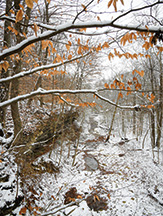
ACRES Land Trust’s Hathaway Preserve at Ross Run in Wabash County features a 2-mile trail, waterfalls, and 75-foot vertical cliff faces. Visit in spring to view wildflowers along the trail. Brent Drinkut photo.
Geology, forest make for stunning landscape
By Scott Roberts, OI StaffThe 2-mile loop trail at Hathaway Nature Preserve allows you to see how glaciers and time can form canyons, starting from ground level to a perch 75 feet up, all while offering views of a waterfall that seems to get bigger as you approach it.
The remains of prehistoric glacial Lake Maumee helped form the area’s topography. The lake drained when the glaciers receded and left a low-lying area that’s now the Wabash River valley. In the aftermath the river flow deepened the valley. As a result of this event, many of the Wabash River’s tributaries ended up higher in elevation than the valley and flow into it. An example is Ross Run, which cut Hathaway’s gorge.
To read the rest of this article subscribe to Outdoor Indiana or pick up a copy at one of our state park inns. To subscribe, click here or call (317) 233-3046.
Reader Photos
Each issue, Outdoor Indiana staff will select reader submitted photos to feature in the magazine. If you would like the chance to be featured, please submit your photo, along with your name and phone number to:
Please, only submit original photography that you have taken. Do not send files over 9 MB in size. JPG format is preferred.
Subscribe to Outdoor Indiana magazine
Visit the Indiana State Parks online store to subscribe. Cost is $15 for a one year subscription (6 issues) or $28 for two years (12 issues).
Donate
Printing and distribution costs for Outdoor Indiana magazine have increased. One way we’re offsetting these costs is through the Friends of Outdoor Indiana Group administered through the Indiana Natural Resources Foundation. Donations to our friends group helps keep our subscription price low and ensures we’ll be around to bring you the best of Indiana’s outdoors for years to come. Donate at the INRF website and include “Friends of Outdoor Indiana” in the “In Honor Of/In Memory Of” line.
Outdoor Indiana
402 W. Washington St., W255-B
Indianapolis, IN 46204
317-233-3046
OIorders@dnr.IN.gov

